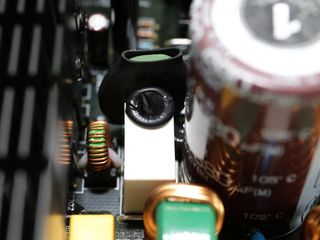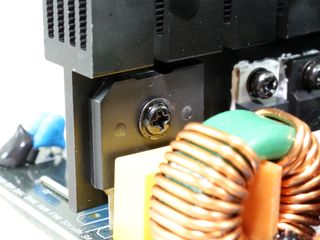EVGA SuperNOVA 750 P2 PSU Review
Another EVGA P2 is on our test bench today. The 750 P2 features 750W max power, modular cabling and Japanese caps throughout. This PSU promises high performance and increased reliability, so it looks to be a great choice for enthusiast PCs.
Why you can trust Tom's Hardware
A Look Inside And Component Analysis
Parts Description
Before proceeding with this page, we strongly encourage you to a look at our PSUs 101 article, which provides valuable information about PSUs and their operation, allowing you to better understand the components we're about to discuss. Our main tools for disassembling PSUs are a Thermaltronics soldering and rework station and a Hakko FR-300 desoldering gun.
| Primary Side | |
|---|---|
| Transient Filter | 4x Y caps, 2x X caps, 2x CM chokes, 1x MOV |
| Inrush Protection | NTC Thermistor & Relay |
| Bridge Rectifier(s) | 1x |
| APFC MOSFETs | 2x Infineon IPI50R199CP (550V, 11A @ 100 °C, 0.199Ω) |
| APFC Boost Diode | 1x CREE C3D08065A (650V, 8A @ 152 °C) |
| Hold-up Cap(s) | 1x Nippon Chemi-Con (400V, 680uF, 2000h @ 105 °C, KMR) |
| Main Switchers | 2x Infineon IPI50R140CP (550V, 15A @ 100 °C, 0.14Ω) |
| APFC Controller | Infineon NCP1653A |
| Switching Controller | AA9013 |
| Topology | Primary side: Half-Bridge & LLC Resonant Converter Secondary side: Synchronous Rectification & DC-DC converters |
| Secondary Side | |
| +12V MOSFETs | 6x Infineon IPP041N04N G (40V, 80A @ 100 °C, 4.1mΩ) |
| 5V & 3.3V | DC-DC Converters: 8x Infineon IPD060N03L G PWM Controller: 2x NCP1587A |
| Filtering Capacitors | Electrolytics: Nippon Chemi-Con (105 °C, KY, KZE, KRG) Polymers: Nippon Chemi-Con |
| Supervisor IC | AA9013 & LM324ADG |
| Fan Model | Globe Fan RL4Z B1402512HH (140mm, 12V, 0.5A, 1800 RPM, 135.74 CFM, 36.7 dB[A], DBB) |
| 5VSB Circuit | |
| Rectifier | 1x Mospec S10C60C SBR |
| Standby PWM Controller | 29604 |






This is the same platform we saw in the 850 P2 and 650 P2. It's made by Super Flower and based on that company's modern Leadex Platinum family design. A half-bridge topology is used on the primary side, along with an LLC resonant converter. On the secondary side we find a synchronous design with six FETs regulating the +12V rail and a couple of DC-DC converters generating the minor ones. Contrary to other high-end implementations, where the +12V FETs are installed on the main PCB's solder side, this unit's FETs are bolted on two small heat sinks. This means the chassis doesn't play an important role in cooling. All filtering caps are provided by a Japanese manufacturer (Chemi-Con), while the cooling fan uses double ball-bearings. Although FDB fans are considered to be higher-quality, a good DBB fan will still last a long time, especially when it's backed by a semi-passive mode.




As we've come to expect from Super Flower-made PSUs, the AC receptacle doesn't host any EMI filtering components. They're all installed on the main PCB, and include four Y caps, a pair of X caps, a couple of CM chokes and an MOV.

An NTC thermistor provides protection against large inrush currents. A bypass relay allows it to cool down quickly.

The single bridge rectifier is bolted on the primary heat sink. Its markings are hidden from view, so we weren't able to identify it. It is hard to desolder large heat sinks and we usually avoid messing with them. However, with our new desoldering gun, a Hakko FR-300, this process will be less painful.







Two Infineon IPI50R199CP are used in the APFC converter, and the boost diode is a CREE C3D08065A. The single bulk cap is provided by Chemi-Con (400V, 680uF, 2000h @ 105 °C, KMR). Its capacity is high enough to offer more than 17ms of hold-up time. But its voltage rating should be a little higher (at least 420V), since 400V is close to the APFC's DC bus voltage (around 380VDC).


The vertical PCB shown above hosts the APFC controller, an NCP1653A IC provided by On Semiconductor.





Two small heat sinks hold the primary switchers, two Infineon IPI50R140CP FETs, arranged into a half-bridge topology. An LLC resonant converter provides a significant efficiency boost, especially at higher loads, and the main controller is a proprietary Super Flower IC with model number AA9013. Most likely the same IC also handles the PSU's protection features. There's also a LM324ADG quad op-amp on the same PCB hosting the AA9013.



A synchronous design is used on the secondary side. Two small heat sinks hold six Infineon IPP041N04N G FETs responsible for generating the +12V rail. EVGA's 850 P2 uses six Infineon IPP023N04N G FETs for the same purpose, which have a much lower Rds(on) value (2.3mΩ instead of 4.1mΩ).





All filtering caps, both polymer and electrolytic, are provided by Chemi-Con. The electrolytic caps are rated at 105 °C and the large ones belong to the KZE family, while the smaller ones are from the KY line.




Two DC-DC converters generate the minor rails. Each one uses four Infineon IPD060N03L G FETs, along with a NCP1587A PWM controller. Metal shields above the FETs provide EMI protection.


An LM324ADG op-amp is used by the fan controller's circuit. As usual, we applied a lot of glue to the fan controller's PCB base in order to safely detach the fan and ECO switch headers. Without glue, you can easily break the base's soldering joints while trying to detach the headers mentioned above.

Next to the fan control PCB is a Mospec S10C60C SBR, which regulates the 5VSB rail.

The standby PWM controller is a small IC with a "29604" marking. There is no info available on this IC, unfortunately.





Lots of Chemi-Con polymer and electrolytic caps provide some extra ripple filtering on the modular PCB. The electrolytic caps belong to Chemi-Con's KRG line, which has a limited 1000-hour lifespan at 105 °C. This is a low-stress area, so caps with shorter lifetimes shouldn't cause any problems. But we'd still like to see higher-quality caps in this area.








Soldering quality is good, though not quite up to the level of other Super Flower-made units we've reviewed. In addition to its own factory, Super Flower contracts out with third-party manufacturing lines. Unfortunately, we cannot identify the factory that produced this PSU. Some component leads are longer than we'd like, though not so long they'll create issues.


The fan is made by Globe Fan and its model number is RL4Z B1402512HH (140mm, 12V, 0.5A, 1800 RPM, 135.74 CFM, 36.7 dB[A]). This is a quality double ball-bearing fan that typically spins slowly due to its relaxed profile. If you enable the semi-passive mode, you have to apply fairly high loads to engage the fan. The fan's minimum speed is fast enough to register 36 dB(A) on our measurement equipment, and unfortunately only three steps are exposed along the curve. In our opinion, EVGA (or Super Flower) should provide a more sophisticated fan control circuit and use a fan with a lower start-up voltage.
Current page: A Look Inside And Component Analysis
Prev Page Packaging, Contents, Exterior And Cabling Next Page Load Regulation, Hold-Up Time And Inrush CurrentStay on the Cutting Edge
Join the experts who read Tom's Hardware for the inside track on enthusiast PC tech news — and have for over 25 years. We'll send breaking news and in-depth reviews of CPUs, GPUs, AI, maker hardware and more straight to your inbox.
Aris Mpitziopoulos is a Contributing Editor at Tom's Hardware US, covering PSUs.

Ampere rides again as Nvidia unveils single-slot RTX A1000 and A400 for professionals — the latter featuring a massively cut-down GA107 chip

Micro Center offers just $700 for $1,400 RTX 4090 - offer came via store's GPU trade-in program

'Enhanced' Nvidia A100 GPUs appear in China's second-hand market — new cards surpass sanctioned counterparts with 7,936 CUDA cores and 96GB HBM2 memory
-
Nuckles_56 Thanks for the review Aris. I'd have to say that I'm very impressed with the performance of this unit, it is excellent. It is also nice to see that it has no issues with holdup times either.Reply -
theyeti87 It was the P2 650 review on Tom's that helped me decide on buying that unit. Same as this, just 100 watts less powerful. Extremely happy with the stability and quiet operation. Very reliable units!Reply -
AfiliaSaga I have their G2 750W superflower unit, fantastic performance couldn't be happier with it.Reply -
refillable Another great product from EVGA. I regret belittling EVGA with their early PSUs. I also mistakenly said, "I don't like that EVGA PSU"...Reply
With SuperFlower, they're known to bring greatness now. Anyone looking for "Good PSUs" should go straight to these units and buy them. Exceptional value with excellent performance. Sadly, they're still not available in my country. -
dstarr3 Reply18119171 said:Another great product from EVGA. I regret belittling EVGA with their early PSUs. I also mistakenly said, "I don't like that EVGA PSU"...
With SuperFlower, they're known to bring greatness now. Anyone looking for "Good PSUs" should go straight to these units and buy them. Exceptional value with excellent performance. Sadly, they're still not available in my country.
Right on. Unless you need significantly more or significantly less power, there's no reason to buy anything else.